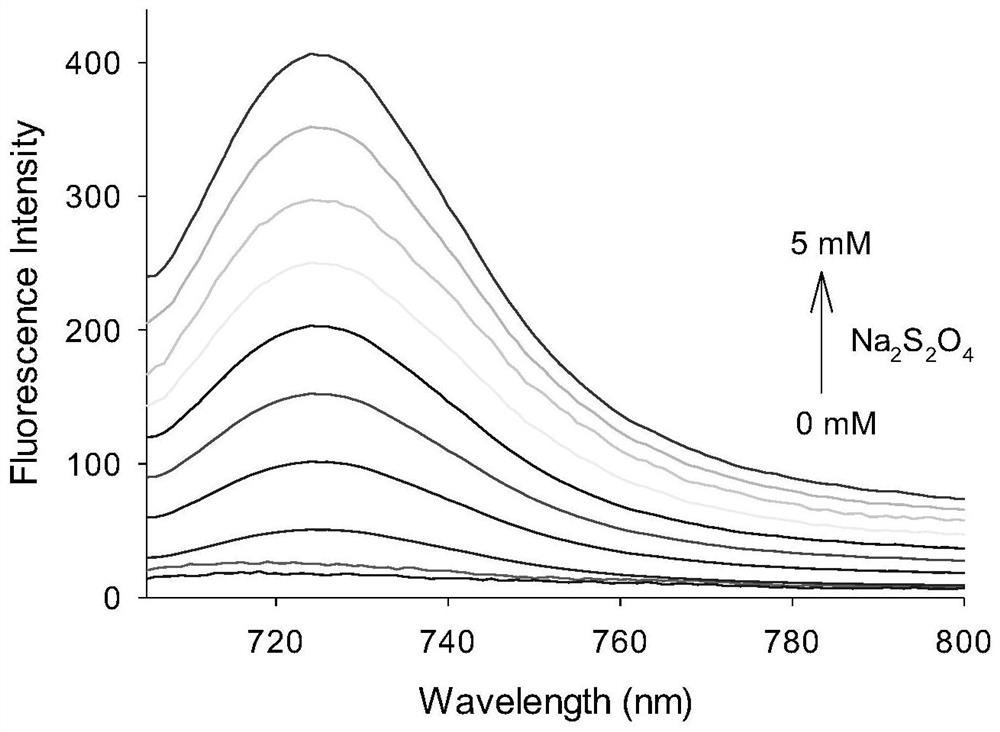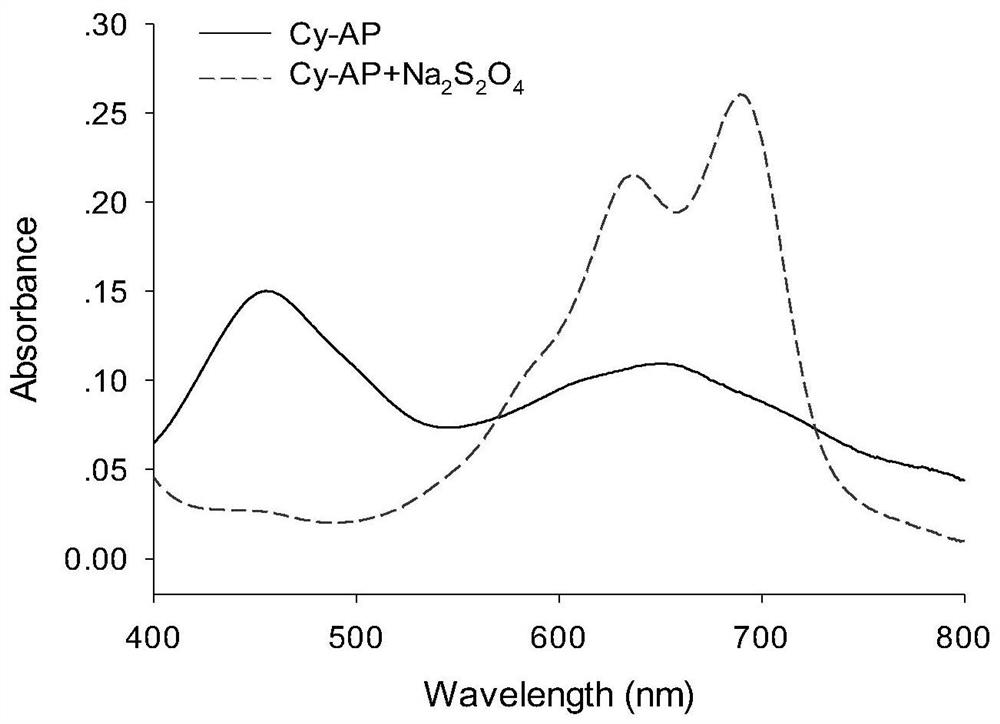Preparation and application of a hypoxic fluorescent probe based on hemicyanine dye
A fluorescent probe and semicyanine technology, applied in the field of fluorescent probes, can solve problems such as interference, short emission wavelength of fluorescent probes, unfavorable deep tissue imaging detection, etc.
- Summary
- Abstract
- Description
- Claims
- Application Information
AI Technical Summary
Problems solved by technology
Method used
Image
Examples
Embodiment 1
[0024] Synthesis of fluorescent probes
[0025] Synthetic route such as figure 1 . In a 100mL round bottom flask, add 10mL containing Cy-NH 2 (0.17g, 0.3mmol) CH 3 CN / CH 2 Cl 2 (1:1) mixed solution, added concentrated hydrochloric acid (0.05mL, 1mmol) at 0°C under nitrogen protection, and stirred well. Next, the NaNO 2 (0.02g, 0.3mmol) of distilled aqueous solution was slowly added dropwise to the above reaction solution, and the stirring was continued for 30min. Then, an aqueous solution of sulfamic acid (0.06 g, 0.6 mmol) was added and stirring was continued for 10 min. Subsequently, CH containing phenol (0.16mL, 1.8mmol) 3 The CN solution was added to the reaction solution, and the pH was adjusted to 6.0. Under the same conditions, the stirring was continued for 1.5 h. After the reaction was completed, dilute with water and dilute with CH 2 Cl 2 extraction. The organic layer was collected, washed with brine, anhydrous Na 2 SO 4 Dry, filter and concentrate. Th...
Embodiment 2
[0027] Fluorescent probes and Na 2 S 2 o 4 Solution preparation
[0028] Preparation of probe solution: Weigh a certain amount of probe solid and dissolve it in methanol to make 1×10 -4 M probe solution. Na 2 S 2 o 4 Preparation of the solution (preparation for current use): weigh a certain amount of Na 2 S 2 o 4 Dissolve the solid in distilled water to make 1×10 -1 M detection solution. will be 1.0×10 -1 Na of M 2 S 2 o 4 The solution was gradually diluted to obtain 1.0 × 10 -1 -1.0×10 -3 Na of M 2 S 2 o 4 solution. Mix 1.0 mL of probe stock solution and 1.0 mL of Na 2 S 2 o 4 The solution was added to a 10mL volumetric flask, and after constant volume with buffer solution, the concentration was 1.0×10 -5 M fluorescent probes and 1.0 x 10 -2 -1.0×10 -4 Na of M 2 S 2 o 4 Mix the solutions to be tested.
Embodiment 3
[0030] Fluorescent probes and Na 2 S 2 o 4 Determination of the fluorescence spectrum of the action
[0031] figure 2 as fluorescent probe and Na 2 S 2 o 4 The fluorescence spectrum of the action, the concentration of the fluorescent probe is 10μM, Na 2 S 2 o 4 The concentrations are 0, 1.0, 1.5, 2.0, 2.5, 3.0, 3.5, 4.0, 4.5, 5.0mM in turn. The excitation wavelength used in the experiment is 680nm, and the emission wavelength range is 705-800nm. The slit width is 10.0 nm / 10.0 nm, and the fluorescence measurement instrument used is a Hitachi F4600 fluorescence spectrophotometer. From figure 2 It can be seen that adding Na 2 S 2 o 4 Before, due to the quenching effect of the azo bond, the fluorescent probe had no fluorescence emission peak; adding Na 2 S 2 o 4 Afterwards, a near-infrared fluorescence emission peak appeared in the near-infrared region (725nm). This is because the probe molecules are surrounded by Na 2 S 2 o 4 Reduction, resulting in the bre...
PUM
| Property | Measurement | Unit |
|---|---|---|
| width | aaaaa | aaaaa |
Abstract
Description
Claims
Application Information
 Login to View More
Login to View More - R&D
- Intellectual Property
- Life Sciences
- Materials
- Tech Scout
- Unparalleled Data Quality
- Higher Quality Content
- 60% Fewer Hallucinations
Browse by: Latest US Patents, China's latest patents, Technical Efficacy Thesaurus, Application Domain, Technology Topic, Popular Technical Reports.
© 2025 PatSnap. All rights reserved.Legal|Privacy policy|Modern Slavery Act Transparency Statement|Sitemap|About US| Contact US: help@patsnap.com



